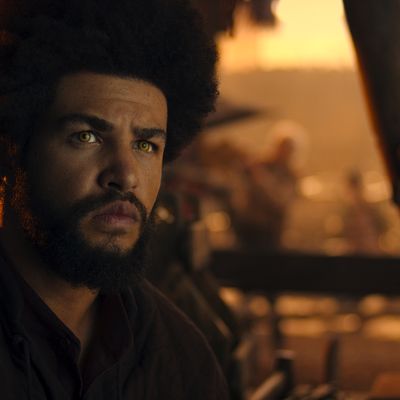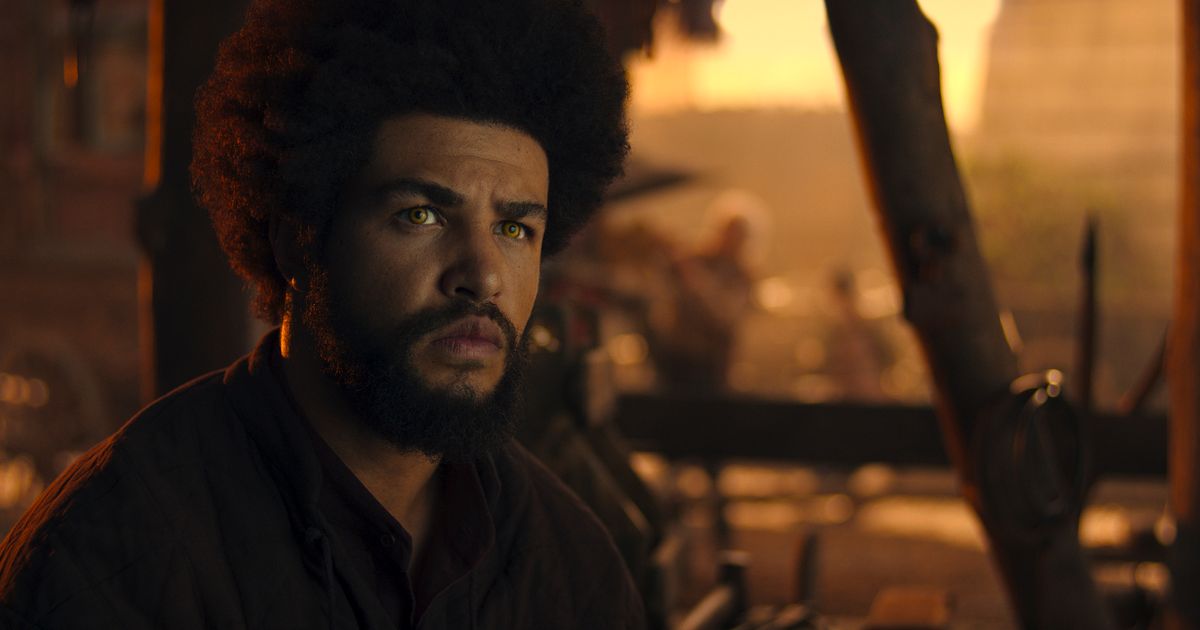
It was clear from the jump that this week’s installment of The Wheel of Time was all Perrin Aybara, all the time. Its title, “Goldeneyes,” only served as further confirmation. For several episodes, we’d seen Perrin and his friends steel themselves for the threat of rapacious, fanatical Whitecloaks on one side and unstoppable trollocs and their human darkfriend allies and commanders on the other. Even before the cold open plays, it’s clear this will be the episode in which Perrin & Co. make their stand.
Self-contained battle episodes of this sort date back to “Blackwater,” the penultimate episode of Game of Thrones‘s second season and, arguably, the show’s best and most important hour. (This episode’s writer, Dave Hill, is a Goth alum.) Working from his own source material, screenwriter George RR Martin gave director Neil Marshall (The Descent) a note-perfect blend of slowly building tension, uneasy camaraderie, surprising character moments, and truly spectacular action. I’ll never forget that massive green wildfire explosion in Blackwater Bay, that’s for sure.
Nothing in “Goldeneyes,” Perrin’s eponymous showcase episode, rises to that level. In part, this is because Perrin and his gaggle of supporting players are simply less compelling as characters and screen presences than Tyrion Lannister, the Hound, Bronn, and so on. Indeed, of Perrin’s entire core crew — himself, his warrior gf Faile, his mountainous Ogier buddy Loial, Loial’s loyal Aiel spear-maiden sidekicks Bain and Chiad, his rival Dain Bornhald, assorted townsfolk, et cetera — only Perrin, the grieving Aes Sedai, Alanna, and her Warder, Maksim, have been fleshed out in terms of their desire, joy, and pain. Everyone else is just sorta there to help out the main character.
That the episode works at all is a testament to the increasing confidence with which showrunner Rafe Judkins and his team approach the material. Gone are the first-season days of COVID-shrunken shooting schedules and resulting battles that feel like a handful of extras sharing the same costumes and props. Nothing speaks to this sense Wheel is finally feeling itself quite like the way the big battle begins: during the daytime, with allies and enemies clearly visible on the screen instead of obscured by the glossy blackness of a streaming TV show.
When those trollocs and darkfriends come over the barricades obstructed by Perrin and his people, you can really see them coming, and you can really see what the people of the Two Rivers will beat them back. The individual heroism of the townsfolk, the supernatural aid of Alanna and the local channelers with whom she links to fuel her ice attack on the enemy — it’s crystal clear.
Equally clear is the geography of the battlefield, which is a key element of successful combat filmmaking dating back to Helm’s Deep and The Two Towers. Perrin, Alanna, and the others have narrowed the approaches to the village down to just one, a narrow mountain pass that’s easily defended. When superior numbers and the temporary wounding of Alanna render the position untenable, the defenders fall back to the town gates and walls. When those fall, they retreat to the town square, forming an old-school phalanx and defending on all sides.
This renders the stakes of the battle crystal clear at all times. If we win, we hold our ground. If we lose, we fall back, until there’s nowhere else to fall back to. Clear, intelligible, physical consequences for success or failure in combat are crucial to building effective battle sequences, and Wheel comfortably passes that test this week.
But just as important is all the buildup. Maksim jokes with Alanna that they’re all going to die. Perrin tries to force Faile to leave, and Faile is like, “lol, yeah, right.” Loial tries to release the Aiel from their bonds to him by deliberately throwing a bloody game of Maiden’s Kiss, only to accidentally cement those bonds even deeper. The Cauthon sisters giggle their way through their magical training, eager to get to the part where they can shoot fireballs. It’s not exactly the Hound and Bronn facing off in a tavern with nude women on their laps, but it’s something.
The battle itself is almost a debacle. Although the defenses devised by Perrin hold for a long time despite there being only a grand total of three professional soldiers in the entire village — Faile, Bain, and Chiad — the good guys are betrayed from within. When Dane, chief of the Children of Light, swallows his pride and agrees to help the villagers in exchange for Perrin’s surrender at the end of the battle, he’s taken by surprise by enemy agents in their midst, led by season one’s minor antagonist, Padan Fain. He’d been leading a group of darkfriends in Children of the Light’s clothing, and they turned on their erstwhile comrades at the worst possible moment.
But Perrin has figured something out. The trollocs, whose battle plan is usually just “run amok,” are fighting in armor and with clarity of purpose. Someone or something is controlling them, he reasons. When he finally corners Padan Fain, he drags out the answer: Fain himself is organizing the assault using magic powers. Perrin agrees to spare the infamous darkfriend’s life in exchange for calling off the invasion. (I’m not sure why just killing the guy, an obvious piece of shit who will never stop causing trouble, isn’t an option, but I leave that to Robert Jordan scholars to explain.)
While all this is going on, Loial, Bain, and Chiad travel to the nearby Waygate, through which Fain has called a whole legion of trolloc reinforcements. But that can’t happen if Loial destroys the gate, which he says he can only do from the inside. After absolutely slaughtering the handful of guards left behind, Loial asks Bain and Chiad to defend the gate from the outside while he tries to shut it down from the inside. But when his mighty hammer proves insufficient to break the gateway itself, he does the next best thing: He breaks the floating land bridge that leads to the gate, sending both it and him plummeting into this nether-dimension’s bottomless chasm. Pour one out for the big boy.
He’s not the only relatively major character who dies this episode. The loathsome Eamon, who’s been dogging Perrin and his companions’ footsteps from the start, gets burned alive by the powerful Cauthon sisters; watching him shriek in agony as the flames consume him, Alanna actually laughs. This is the moral calculus of battle.
Meanwhile, a visiting company of the pacifist fake Irish Travelers called the Tuatha’an have sought refuge in the village too, and Perrin’s counting on these non-fighters to run the town’s children to safety. This they do, but not before a trolloc who runs on all fours in delightfully janky pseudo-stop-motion fashion (he looks like one of the Zuul dogs from Ghostbusters) catches up with them. Aram (Daryl McCormack), a strapping Tuatha’an man, grabs the beast’s knife and kills it — violating a strict taboo against violence in front of the eyes of Ila (Maria Doyle Kennedy), the group’s leader. This means he’s persona non grata in the group, but fortunately there’s room for him in the Two Rivers as a blacksmith.
That’s because the blacksmith is turning himself in. Honoring an agreement he made with Dane earlier in the episode, a triumphant Perrin turns himself in to the Whitecloaks. He’s led off in shackles even as the people hail him as Lord Perrin Goldeneyes, an exemplar of the fallen kingdom of Manetheren, which once stood in the area. Alanna keeps saying this noble lost realm’s blood flows in the veins of the locals. Perrin’s self-sacrifice proves the point. Hell, they even designed a new royal banner with a wolf’s head as a sigil in his honor.
Speaking personally, I’m a huge sucker for fantasy combat. I can still remember getting excited about it Braveheart because, for the first time, I was seeing something like what I imagined while reading The Lord of the Rings. So I’m delighted by an episode like this, especially one that takes such great pains to make clear what’s happening and why. In particular, there’s a sequence in the town square that prominently features Faile, in which each kill is captured with minimal camera cuts, allowing the viewer to appreciate the elaborate fight choreography and the visual and practical effects used to enhance it.
Perhaps the true purpose of the hour is to give what professional wrestling fans refer to as “the rub” to Perrin Aybara. Actor Marcus Rutherford has long been the core cast member I have the hardest time wrapping my head around; his mumble-mouthed affect makes sense when he’s the bereaved husband of a woman he killed accidentally while trying to save her, but much less so as a werewolf warlord whose people are straight-up inventing banners and sigils on his behalf. But when you depict him as a reluctant fighter whose main goal is to win so he can turn himself in to face the Light’s justice, that monotone makes more sense.
After the smoke clears, the main thing I’m left wondering is how this season wraps everything up with just one episode to go. By my count, there are … five times nine divided by seven, carry the 12 … too many story lines going on right now to even cover in a recap, much less squeeze into a finale. The hunt for Liandrin and the Black Ajah, Rand becoming the Aiel messiah, Egwene and Moiraine going through their own shit, a whole bunch of Forsaken floating around … even assuming the final episode is extra long, that’s a lot to cram in.
But I don’t mind the show taking a one-episode detour just to focus on one particular character. This is the kind of thing that Wheel does best, and it anchors and enhances its usual cast-of-thousands approach. The Two Rivers will survive, and with a few more episodes like this, so will The Wheel of Time.

اترك تعليقاً